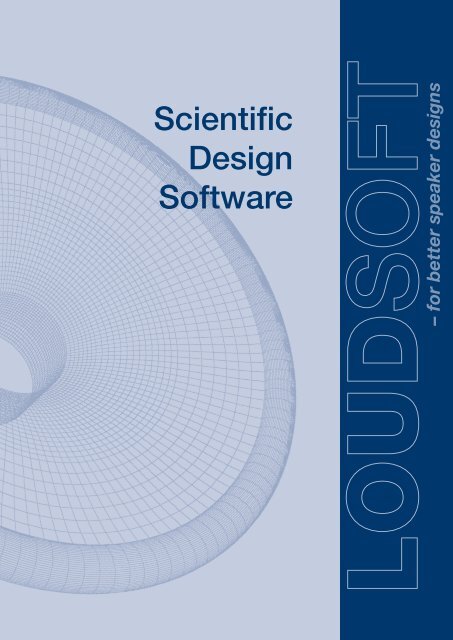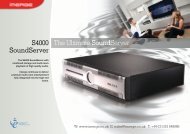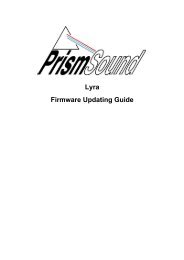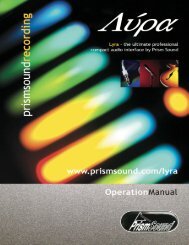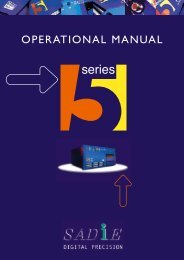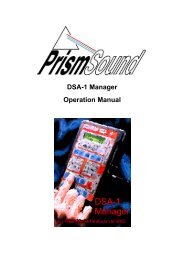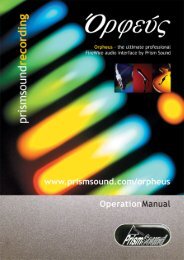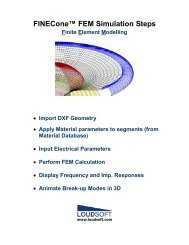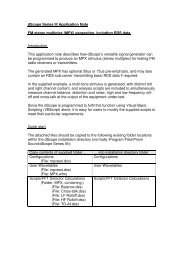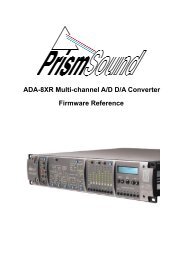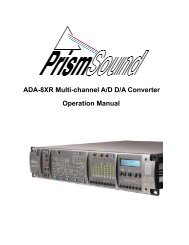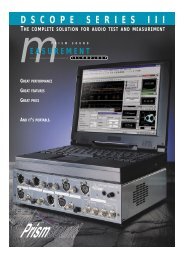Download the full LOUDSOFT brochure
Download the full LOUDSOFT brochure
Download the full LOUDSOFT brochure
- No tags were found...
You also want an ePaper? Increase the reach of your titles
YUMPU automatically turns print PDFs into web optimized ePapers that Google loves.
ScientificDesignSoftware– for better speaker designs
FINEMotorMagnet System & Voice Coil Design ProgramThe FINEMotor program is <strong>the</strong> unique simulation tool forprediction of SPL & T/S parameters including Xmax and wirediameter. FINEMotor is also <strong>the</strong> unique simulation tool fordesigning <strong>the</strong> magnet system, voice coil and spider for woofers,domes, telephone-receivers, headphones etc.Neodym U-cup system withmin dimensions, to avoidsaturatiomPrecise and FastWhen SEAS was designing a new product line and usedFINEMotor for <strong>the</strong> first time, <strong>the</strong> result was right on target andsaved <strong>the</strong>m a lot of time. After this first attempt SEAS now workswith FINEMotor for all new motor systems.Material databaseWith <strong>the</strong> latest version of FINEMotor you can add your ownmagnets and wires to <strong>the</strong> database, which already has a lot ofstandard Chinese materials to choose from.Special Features:• Accurate prediction of SPL, T/S parameters and winding data• Round and edge wound copper, aluminium and CCAW wires.• Fs is calculated from Cone Fo and spider deflection/ Resonance/flexibility.• Ferrite, neodymium and user specified magnetic material• Automatic magnetic compensation of air gap for larger wiresor multi-layer VC´s• Twin voice coil 2+2 layers in parallel• Shielded/unshielded – only one buttonclick• Saturation shown in top plate, pole andback plate• Qms is estimated by including VCformer losses for Alu or Kapton• Selection between steel or non-steelframe• Updated internal flux models: T-Pole,extended Pole• Up/down offset of Voice coil nowstandardFINEMotor Main Screen2
FINEMotor ExamplesNew designs:• You can design an 8 inch long throw subwoofer with shieldingand for instance a Qts=0.33, plus calculate <strong>the</strong> spider deflection+ stiffness to get Fs=28Hz. The program gives you all windingdata for <strong>the</strong> 3.35 ohm Voice Coil.• Design a given size motor and get maximum BL, even whenusing a steel frame.• With FINEMotor you can check <strong>the</strong> symmetry of <strong>the</strong> woofermagnet gap flux and move <strong>the</strong> Voice Coil up/down to find <strong>the</strong>best position. Calculate BL(x) at for example 2 and 5mm aboveand below <strong>the</strong> air gap.• Design an optimum one layer Copper Clad Aluminum VoiceCoil for a compression driverModifications of existing designs:• You want to try a long 4 layer Voice Coil, but don’t know howto predict <strong>the</strong> BL and Qts because <strong>the</strong> air gap is changed?Just input <strong>the</strong> 4 layers and <strong>the</strong> clearance you want betweenVoice Coil and top plate. FINEMotor will give you a choice ofsolutions with increasing Xmax. Just pick <strong>the</strong> one you wantand all winding data + motor dimensions are calculated foryou.• Add shielding cup + rear magnet to a woofer without changing<strong>the</strong> TS parameters.• Optimize <strong>the</strong> sensitivity of a neodymium dome tweeter byusing <strong>the</strong> best neodymium disk size.Problem solving:• Our current woofer is very good, but has too low impedancefor our amplifier. Here you can modify <strong>the</strong> Voice Coil and motor,and still keep <strong>the</strong> TS parameters.The voice coil, indicatedby <strong>the</strong> yellow lines, isoffset +1.87mm (down).All T/S parameters arerecalculated instantly.3
FINEConeAcoustic Finite Element Dome/Cone Simulation ProgramThe FINECone program gives you freedom to use your time andcreativity to design better loudspeakers. Within seconds you cancalculate <strong>the</strong> Frequency Response for a new driver or analyseyour problems with an existing driver. FINECone can drasticallyreduce time-to-market for new products.1 inch Aluminium Dome withproblem at 15 kHz. SimulatedresponseFINECone 3D animationshows mode at 15 kHz1 inch Aluminium domewith solved problem at 15kHz, by adding glue joint.Simulated responseSave Engineering TimeHigh accuracy calculations in FINECone only take 5-30 seconds.Save Tooling & CostsFINECone predicts <strong>the</strong> performance so well that you only needto build one prototype instead of trial-and-error experiments.Better ProductsUse <strong>the</strong> Material Database to find <strong>the</strong> best driver componentsand optimize <strong>the</strong> cone thickness or stiffness that fits your exactdemands.Problem free productionOptimising <strong>the</strong> development process streamlines <strong>the</strong>production so you don’t have to spend your time firefighting.New Features• DXF error tracking• Export of response curves with phase• Automatic air load calculation• Frequency response over plot• Library of DXF and FINECone models• Import of TS parameters fromFINEMotor• Undo in 10 levels• Improved whizzer cone calculation• Chinese interfaceFINECone 1 inch Alu Dome Break-up mode @ 26451 Hz4
FINECone ExamplesNew Designs:In <strong>the</strong> design process for a completely new woofer <strong>the</strong> cone andsurround is a big challenge, because <strong>the</strong> response is not knownand no dimensions exists.With FINECone this situation is elegantly handled and <strong>the</strong> usercan quickly simulate many different cone shapes, and play withthicknesses etc. plus surround roll dimensions as well as dustcaps, glue joints and even voice coil former materials.FINECone Simulated andMeasured 6” WooferThe design of dome tweeters is even more demanding, butnot with FINECone. Here you can simulate <strong>the</strong> thinnest domediaphragm up above 50 kHz and optimize <strong>the</strong> dome andsurround shape, as well as a very thin glue joint.Modification of existing designs:If you are not satisfied with a standard product you can simulateit in FINECone and find out what can be improved. It is very easyfor example to change <strong>the</strong> cone material to Kevlar, Titanium oreven more exotic materials like Beryllium.Problem SolvingMaybe you have designed a nice looking woofer with an inverteddust cap, but unfortunately with bad response already around1300 Hz. By exporting <strong>the</strong> response to FINE X-over we find that<strong>the</strong> x-over cannot remedy this problem. However <strong>the</strong> FINEConesimulation shows that <strong>the</strong> surround is <strong>the</strong> problem. The simulatedsolution is found easily and corrects <strong>the</strong> problem <strong>full</strong>y.FINECone mode @ 1308HzSimulation of ImprovedwooferAno<strong>the</strong>r example is a Chinese made Silk Dome Tweeter whichhas a response problem at 7 kHz. The simulation revealed that<strong>the</strong> dome edge and surround was breaking-up at this frequency.A possible solution was an additional glue joint to stiffen <strong>the</strong>edge. However that adds mass giving a lower SPL. A bettersolution was found by changing <strong>the</strong> bad geometry to avoid <strong>the</strong>problem without loss of efficiency.Simulation of ImprovedDome5
FINE X-overX-over Simulation ProgramOur customers are extremely impressed with Fine X-over 3.1.It is amazingly fast to use and has a clean uncluttered userinterface. But best of all: it will cut down your development timewith many hours per day.You can see <strong>the</strong> response change immediately by rolling <strong>the</strong>mouse-wheel through standard E24 components.Or let <strong>the</strong> intelligent optimizer find <strong>the</strong> best flat response whilekeeping <strong>the</strong> minimum impedance and calculating <strong>the</strong> real powerin all components.Features:• Intelligent optimizer for response and minimum impedance• Response will change immediately when rolling <strong>the</strong> mousewheelthrough standard E24/E12… components• Automatic power calculation of each component• Preview of LMS, MLSSA, CALSOD, SOUNDCHECK…..driverresponse and impedance files• Asymmetric LP and HP filter slopes in Band-pass• Additional components for baffle compensation etc.• Cascaded sections i.e. 2.woofer can be tapped from1. woofer• Time/distancecompensation• Variable target with slopes• Both ON- and OFFaxisresponses can beoptimized at <strong>the</strong> same time• Chinese user-interfaceYou can see <strong>the</strong> response change immediately by rolling <strong>the</strong>mouse-wheel through standard E24 components.6
FINE X-over ExamplesNew Designs:Simulate a completely new x-over using <strong>the</strong> real measuredresponses from prototypes. Or simulate <strong>the</strong> x-over withsimulated responses from FINECone even BEFORE building <strong>the</strong>first prototype!Use FINE X-over to simulate 1st/2nd or up to 4th order x-overwith or without compensation networks. The program willautomatically indicate which components are redundant, and<strong>the</strong>reby save component costs.FINE X-over driver inputThe Network Power feature is used to calculate <strong>the</strong> (IEC) powerin all drivers and components in order to avoid overload in <strong>the</strong>finished x-over.The intelligent optimizer will optimize BOTH frequency responseAND minimum impedance to avoid too low impedance at anyfrequency, for protecting your amplifier.Modification of existing designs:What if <strong>the</strong> production woofers or tweeters show a differentaverage frequency curve? Import <strong>the</strong> actual driver responseaverage from FINELab (Auto-saved in Statistics), and check<strong>the</strong> deviation from <strong>the</strong> original response in FINE X-over. Nowyou can optimize <strong>the</strong> x-over to give <strong>the</strong> same response with <strong>the</strong>production drivers.SPL + Imp optimizationTweeter power calculationYou may find out that <strong>the</strong> component values in your x-over arenot available in time for production? Just input <strong>the</strong> availablevalues and re-optimize frequency response and minimumimpedance once again.Problem SolvingHaving problems in <strong>the</strong> field with burned tweeters? Redesign<strong>the</strong> x-over in minutes to lower <strong>the</strong> power in <strong>the</strong> tweeter withoutsacrificing <strong>the</strong> good response you had before.Customers complain that your loudspeaker system is causingproblems with certain amplifiers? Redesign your x-over by using<strong>the</strong> button “New based on this” and optimize <strong>the</strong> system withincreased (minimum) impedance.7
FINEBoxNon-Linear High Power Enclosure Simulation ProgramFINEBox is <strong>the</strong> ideal program for optimizing your loudspeakersystem at high power. Use <strong>the</strong> mouse wheel to tune <strong>the</strong> Volumeor Port (FB) in a bass Reflex or Band pass system.The “Time Curtain”.You can even simulate <strong>the</strong> Voice Coil temperature andCompression at high power in Closed Box, ABR, Bass Reflex,Band pass and InterPort systems.Import measured and simulated FSIM and TXT responses frommost o<strong>the</strong>r systems including FINELab.The “Digital Clock”.The “Thermal Model”.FINEBox. Lower display showing spliced response (Blue)Splice imported responses with FINEBox curves and match SPLif needed.Features• Closed Box, ABR, Bass Reflex, Band Pass, InterPort systemsare calculated• 3D Display with “Glass” layer Time Response selection• All Non-Linear T/S pars including <strong>the</strong>rmal data can be importedfrom FINEMotor• Power compression is calculated at any power level and time• View Cone Displacement, Reflex and InterPort speeds at anypower level• Advanced Thermal modelpredicts heating of voice coiland motor• Export simulated and splicedresponses• FINEBox is unique becauseyou can input any TSparameters and directlyget <strong>the</strong> bass response of abass reflex system, ABR orBandpass etc.• Peter Madsen from KEFAudio UK says:“You can change <strong>the</strong> TSparameters in FINEBox untilyou get <strong>the</strong> bass responseyou want! Then build anew woofer with <strong>the</strong>se TSparameters and you have <strong>the</strong>perfect loudspeaker.”8
FINE QCProduction Test SystemThe FINE QC test equipment is developed as a natural additionto <strong>the</strong> simulation programs from <strong>LOUDSOFT</strong>: FINEMotor,FINECone, FINEBox and FINE X-over. The FINE QC system willshare data with <strong>the</strong> o<strong>the</strong>r FINEPrograms and works with <strong>the</strong>intuitive <strong>LOUDSOFT</strong> user interface.The FINE QC production test system is developed to be powerfuland efficient. You can use <strong>the</strong> test system for even <strong>the</strong> smallesttweeters.Features:• Very fast test execution with CHIRP• USB Interface• Robust and reliable• Extremely easy-to-use• Different response limits (adaptive)• Rub and Buzz test• SPL, Impedance, T/S and Polarity measured at <strong>the</strong> same time• Automatic daily average• Automatically finding “Golden” average driver• Available Danish electret microphone• Files to FINECone and FINE X-overDanish microphoneMeasuring box with USB and Built-in 25W amplifier + 48V Phantom9
FINE QC “Golden Average Driver”End of Line QC-Testing withFINE QC and <strong>LOUDSOFT</strong>microphoneFINE QC ”Golden Average Driver” Auto Finder in Pre-production. This featurecan also be used to match Drivers or Speaker systems.All measurements can beexported from FINE QC.Here are two wooferresponses imported intoFINE-XoverWhen starting a new production, <strong>the</strong> most important is to find<strong>the</strong> unit which is closest to <strong>the</strong> average of <strong>the</strong> good units, so itcan be used as reference.A pilot run consisting of 17 woofers for a 2-way system, weresorted using <strong>the</strong> automatic Preproduction Feature, see <strong>the</strong>Figure above. The highlighted driver response (yellow) is SerialNo.8 in <strong>the</strong> table and is <strong>the</strong> best match to <strong>the</strong> average i.e. <strong>the</strong>Golden Average Unit.TS-Parameters are measuredwith curve-fitting using<strong>the</strong> same level (current) asSPL measurementsNote that driver No. 7 was deselected in <strong>the</strong> table because thatresponse was considered non-typical and should not disturb <strong>the</strong>average.Should it be necessary to find a similar reference driver later, thatcan be found by selecting “Best Match to Reference”.The preproduction feature can also be used for "Pair Matching"of loudspeaker systems or drivers, or sorting of units withdifferent response variations.11
FINE QC tests and statisticsFINE QC testsYou can use your own microphone with <strong>the</strong> FINE QC system,or buy <strong>the</strong> inexpensive <strong>LOUDSOFT</strong> electret microphone. Thisvery high quality microphone is produced in Denmark and iscalibrated for <strong>the</strong> FINE QC system.TestingStatisticsFINE QC statisticsThe statistics collected by <strong>the</strong> FINE QC system is designedin such a way that you automatically will get <strong>the</strong> average anddeviation statistics you need, no more – no less.FINE QC tolerancesThe QC system is optimized for production testing. It is extremelyfast and simple for <strong>the</strong> operator. If <strong>the</strong> tested loudspeaker isoutside <strong>the</strong> tolerances, you can see it with just a quick glance.Tolerances12
FINEBuzzThe new Rub & Buzz Method in FINE QCThis new detection method is based on <strong>the</strong> latest Danish researchon hearing mechanisms, using a completely new algorithmto find <strong>the</strong> annoying sounds, which cannot be detected withconventional methods like THD, high harmonics or IM distortion.The signal is measured in <strong>the</strong> Time Domain, and a specialalgorithm is applied to find <strong>the</strong> fast low level impulses, whichare normally masked by noise. Finally <strong>the</strong> result is filtered andtransferred by FFT to <strong>the</strong> frequency domain, whereby <strong>the</strong> Rub &Buzz phenomena can be correlated with <strong>the</strong> actual frequencies.FINEBuzz Detection of 1 tinySugar CrystalThe new FINEBuzz method is extremely sensitive and can detecteven a small sugar crystal ticking on a loudspeaker cone.FINEBuzz Features:• Complete 100% End-of-Line Testing for all loudspeaker driversand cabinets• Very fast in production,
R+D))FINE R+D))Acoustic Measurement SystemFeatures:• Anechoic FFT measurements in rooms with Acoustic Auto-delay• SPL/Frequency and Impedance responses with phase• Multiple Display of 16 or more responses with up/down scroll• Drag and Drop files from VACS, MLSSA, LMS and o<strong>the</strong>rprograms• THD + 2 – 9th harmonics• Cumulative Decay Spectrum “Waterfall”• Room measurements: 1/12 - 1/6 - 1/3 - 1/2 - 1/1 octave Smoothing• Extended Low Frequency measurements• Export of all measurements with phase in *.lab and *.txt format(VACS / Klippel)• Curve library of up to 50 curves/responses/TS parameters etc• Thiele Small parameters: Fixed Mass/Delta Mass/Added Box• Full System calibration incl. Microphone• For Professional USB soundcards with Loudsoft/ASIO drivers14
History<strong>LOUDSOFT</strong> – for better speaker designsPeter Larsen as an engineerPeter Larsen has been working in <strong>the</strong> loudspeakerindustry since 1974. He started his career withSEAS, was Chief Engineer for Vifa 1979-1987 andfor Dynaudio 1987-1990. Until 1993 he workedwith JBL in USA. From 1993 Peter Larsen hasworked as an independent consultant for leadingloudspeaker factories all over <strong>the</strong> world: Audaxin France, KEF Audio in UK, Goldmax in China,Vifa-Speak in Denmark, Peerless Fabrikkerne ofIndia, and NXT in UK.Peter has specialized in in-depth analysis ofloudspeakers and manufacturing techniques,research concerning new components andmaterials, advanced Acoustic Finite Elementmodeling, new measuring methods, novelspeaker design concepts and development ofseveral customized products (private label).Peter Larsen as a musicianFor more than 35 years Peter has been singing in choirs. At<strong>the</strong> same time he is a good piano player and he also plays <strong>the</strong>trombone. Lately he has started to arrange music for <strong>the</strong> Quinte<strong>the</strong> is playing with and he has performed on quite a few CD´sduring his time as a musician.Peter has a very good ear for music and sound. That meansthat he also has a good ear for loudspeakers– which he has proved over <strong>the</strong> years.Peter Larsen as an inventorDuring <strong>the</strong> last 30 years Peter has designedmany new drivers for Dynaudio, JBL, KEFand o<strong>the</strong>r producers, but <strong>the</strong> most impressiveinvention was <strong>the</strong> Ring Radiator: One Fridayafternoon he was working with a dometweeter, but it had problems. As he was tiredand frustrated, he took a big needle andstuck it through <strong>the</strong> dome. The dome wasstill able to play and <strong>the</strong> frequency responsewas flat as a ruler up to <strong>the</strong> limit of <strong>the</strong> B&Ksystem. The Ring Radiator was born.Visitwww.loudsoft.comfor more informationand download freedemos of <strong>the</strong>programs15
– for better speaker designswww.loudsoft.comAgern Alle 3 – 2970 Horsholm – DenmarkPhone +45 4582 6291 – Fax +45 4582 7242E-mail: dl@loudsoft.com


